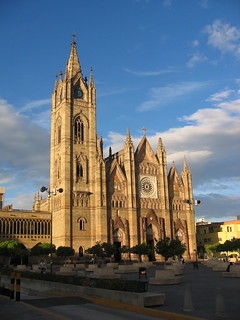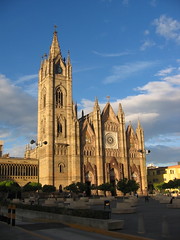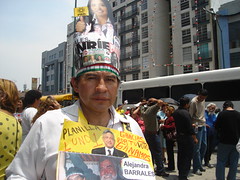A government donation in support of an Archdiocese of Guadalajara construction project raises uncomfortable questions about the separation of church and state in Jalisco.
David Agren
The News
Tlaquepaque, Jal. – In his 14 months in office, Jalisco Gov. Emilio González has seldom shied away from publicly expressing his Catholic faith, his socially conservative viewpoints, or even the cozy relationship he enjoys with the local archdiocese and its leader, Cardinal Juan Sandoval.
Priests from the Archdiocese of Guadalajara lead a weekly Bible study for the governor's Cabinet in his official residence, the Casa Jalisco. Last Spring, with Mexico City on the verge of legalizing abortion, González and Cardinal Sandoval made joint public statements against the initiative.
The socially conservative governor also objected to parts of an AIDS prevention program that would allow for the distribution of condoms to teenagers. He later questioned sarcastically if the government should also provide adolescents with "a six pack of beer … and a hotel voucher."
His antics and pronouncements drew criticism from some local commentators and opposition politicians, but little widespread outrage in Jalisco – one of the Republic's most conservative and Catholic states, a place where martyrs of the Cristero Rebellion are lionized, church-sponsored events are well-attended and the largest chain of pharmacies in the region only started stocking contraceptives earlier in the decade.
But then González handed over 30 million pesos of taxpayer money in late March for the construction of a massive Catholic sanctuary in the Guadalajara suburb of Tlaquepaque – and all hell broke loose.
Guadalajara residents took to the streets in protest and a record number of complaints – more than 6,500 – were filed with the state human rights commission. Calls for the governor's resignation also mounted.
González responded by making another 15-million-peso donation to a church-run food bank and acerbically telling his critics, "Me vale madre, [I don't give a f—k]," in a profanity laced speech at the check presentation banquet.
SEPARATION FROM THE STATUS QUO
The donation – and González's previous antics – are a departure from the historically strict separation of church and state in Mexico, a concept championed since the Reform Laws of Benito Juárez in the 1850s and reinforced by the Constitution of 1917 and subsequent Institutional Revolutionary Party, or PRI, governments.
But the separation encountered resistance in Jalisco and its environs, where the Cristero Rebellion – an uprising against anti-clerical laws that forbade Catholic officials from preaching politics from the pulpit, stripped the church of its rights to own property and banned prelates from wearing clerical garb in public – raged in the late 1920s.
It also spawned several Catholic-friendly political movements, including the National Action Party, or PAN, and a Sinarquista organization, which is currently being revived through a new party.
The church largely exited the political arena after the Cristero Rebellion and coexisted peacefully with the PRI for the proceeding decades.
But with the country gradually opening up, the abolishment of many anti-clerical laws in 1992 and the PAN beginning its ascent to national governance, the church became more assertive in social and political matters – especially in Jalisco, where the PAN claimed power in 1995 and has won three consecutive gubernatorial elections.
"The PAN has found the church – not trade unions and the civil parts of Mexican society – to be its main source of social support," said Ilán Semo Gorman, a history professor at Universidad Iberoamericana in Mexico City.
"In almost every state where you have a PAN governor, what you're going to see is [the party] trying to reconstitute power on the basis of church orientation."
Analysts are at odds over exactly how much the Catholic Church actually influences the PAN, which is divided into pragmatic and religious factions nationally. Party president Germán Martínez – a close confidant of President Felipe Calderón – deposed the religious-conservative wing of the PAN by winning power last December.
Some experts say the religious-conservative wing still holds enormous sway on the state level in Western Mexico, leading to perceptions of church influence over the party. Others disagree.
"It's an aberration," said Jeffrey Weldon, a political science professor at ITAM, referring to the PAN's religious-conservative strains.
He said the party still mostly attracts followers who believe in the separation of church and state. Weldon added that close church-state ties are only found "in maybe half of the PANistas in the Guadalajara area and in certain parts of Guanajuato."
Still, that religious affiliation is the source of much speculation, particularly surrounding "El Yunque," or the Anvil, which is thought to be a secret and deeply Catholic and conservative society.
Gonzalez, according to the local media, is a Yunque member – a charge he denies.
But whether or not the Yunque exists is still up for debate.
"It's exaggerated. It probably exists in some kind of form, but I think it's mostly just a group of people that think similarly, much more than something that looks like the Ku Klux Klan ... or the Masons," Weldon said.
"It's usually more a brush that people are painted with than reality."
FROM THE CATHOLIC HEARTLAND
Gonzalez originally hails from Los Altos, a region of dry highlands northeast of Guadalajara known for tequila, ranching and blue-eyed inhabitants. It was in Los Altos that the Cristero Rebellion flared most forcefully, and to this day, monuments to martyrs like parish priest Toribio Romo, the patron saint of undocumented migrants, attract thousands of visitors.
In the 1930s the region produced the National Sinarquista Union, an anti-communist Catholic group that opposed the revolutionary rhetoric of then President Lazaro Cárdenas, who nationalized the oil industry in 1938, distributed large tracts of hacienda land to landless campesinos and declared that public education be free, secular and "socialist."
The PAN was also founded around the same time. It drew a Catholic following, but unlike the Sinarquistas, the PAN appealed more to urban, middle class and business voters, according to Alan Riding's 1985 book "Distant Neighbors."
González, now 47, began his political career with another Sinarquista group, the Mexican Democratic Party, or PDM, a regionally popular outfit during the 1970s that lost its official standing in 1990s. He even won the mayor's office in his birthplace of Lagos de Moreno for the PDM in the 1980s before drifting over to the PAN later in the decade, becoming state party president, mayor of Guadalajara and eventually governor.
But González only won the gubernatorial seat after waging a negative campaign that saw federal investigators appear on his opponent's doorstep mere days before the 2006 election, acting on a PAN legal complaint regarding the legalization of properties supposedly purchased as part of a money-laundering scheme. The investigation was later dropped.
And González, it was later revealed, had boasted of having another ace up his sleeve: support from the local archdiocese.
A U.S. consular document published last month in Público, a Guadalajara daily newspaper, reported that in 2005, González had bragged about having widespread church support.
"Emilio claimed that high-level church officials in Jalisco have committed that organization to supporting his candidacy," the document read. "Emilio claimed, the Church has committed its 3,000 priests in Jalisco to working for an electoral victory for both him and the PAN."
The Archdiocese of Guadalajara has denied supporting the González campaign and spokesman Antonio Gutíerrez said that Cardinal Sandoval enjoys good relations with politicians from all parties and levels of government.
ALL ABOUT TIMING
The revelation of the supposed church support emerged just as the governor was defending his donation – which will eventually total 90 million pesos – toward the Sanctuary of the Mexican Martyrs, a project valued at 2 billion pesos. The governor has defended the sanctuary plan, saying that the site will promote religious tourism in Jalisco, which is already home to some the country's most popular pilgrimage sites, including San Juan de los Lagos, Talpa and the Basilica of Zapopan.
The money also went to a non-profit civil association responsible for raising funds for the sanctuary's construction – and not the archdiocese – he said.
And in spite of the protests and public outcry – a recent Grupo Reforma survey showed that 57 percent of respondents opposed the governor's actions – the donation came as little surprise to some local observers.
"We have a governor that is very conservative ... and a cardinal that believes religious values should be society's main values," said Víctor Ramos Cortes, a religious studies professor at the University of Guadalajara.
"With this governor, [the cardinal] has a very close relationship … which explains the donation."
That doesn't mean people are happy about where the money's going, however.
Guadalajara resident Mario Díaz, who says he attends Mass at least twice a month, is just one among many. "We don't have enough beds in the Hospital Civil, but the governor goes and gives 90 million pesos to the cardinal," he complained.
But backers of the sanctuary say it will improve local infrastructure like roads and drainage and will include social projects that include a soup kitchen, nursing school and public hospital.
Armando Martínez, president of the College of Catholic Lawyers in Mexico City, accused critics of being "hypocritical," noting that all churches are property of the state and that various levels of government have contributed toward the construction and expansion of the Basilica of Guadalupe – the world's most visited Catholic shrine – and renovations at the Metropolitan Cathedral in Mexico City.
Gutíerrez, the archdiocese spokesman, acknowledged the public dissatisfaction over the donation, and arguments that the money should be directed toward other community projects. But he attributed much of the resistance to the conservative nature of Guadalajara residents and an aversion to large construction projects.
"Guadalajara has a fear of large projects," Gutíerrez said.
"You have to realize that Guadalajara is a city with small buildings. Unfortunately, the Tapatío mentality is a mentality that there shouldn't be any big buildings."
CONVINCING NONBELIEVERS
Even with construction proceeding on the sanctuary, wooing the public – and investors – hasn't been easy, and probably won't be.
Signs lining the road up to the construction site, high up on the edge of the Cerro del Tesoro in Tlaquepaque, speak of the promise of the place.
"Being here is being with God," reads one sign near the sanctuary, which when completed, is expected to seat 12,000 and provide standing room for another 50,000.
Gutíerrez said the site would host Catholic events that currently take place at the local bullfighting ring and Estadio Jalisco, where the church hosted a 2005 service that beatified 13 Cristero Rebellion martyrs.
But investment hasn't been forthcoming. "Large sums of money aren't flowing in," Gutíerrez said, adding that the construction is being carried out with the help of in-kind donations from construction firms.
Ironically, Cardinal Sandoval actually might have alienated many of the business groups that have supported church projects over the years by telling a gathering of journalists last month, "There isn't a single honorable rich person, because working never made anyone wealthy … If that were the way to become wealthy, then donkeys would be the richest."
The cardinal later explained that he had been referring to the annual list of billionaires published by Forbes magazine, but business groups in Western Mexico rebuked the comments, pointing to Sandoval's penchant for rubbing shoulders with the wealthy and his frequent golfing excursions to an exclusive country club.
Ramos Cortes, the religious studies professor, said that many parish priests also privately oppose the project, but are afraid to voice their criticisms.
"All of the temples in the archdiocese have collection boxes so that people can collaborate in the project, but there have been very few donations," he said.
JUDGMENT DAY
Ultimately, the construction of the sanctuary, investment in it or lack thereof, and public opinion could be litmus tests for religious power in the region.
The lack of donations and immense criticism of the Sanctuary of the Mexican Martyrs, according to Ramos Cortes, reflect a changing social dynamic in Guadalajara, which, while remaining solidly Catholic, is becoming less fervent in its zeal for religious meddling in social and political matters.
"The governor thinks that with this [donation] he's going to win over Catholics, but in my opinion, he's making a bad calculation," Ramos Cortes said.
"Catholics are gradually developing a more critical attitude toward the political maneuverings of the local clergy – and particularly this cardinal."





